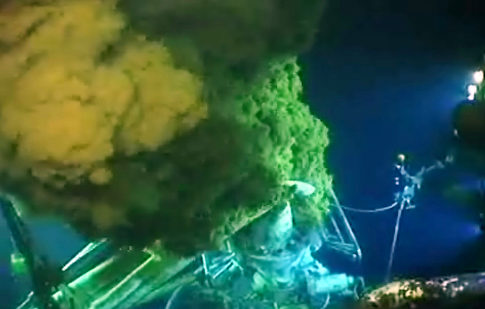Nuke the Deepwater Horizon wellhead? The thought had occurred to me, over the past six weeks watching environmental catastrophe unfold in the Gulf of Mexico, that detonating a nuclear bomb at the oil well blowout site a mile below the water's surface could work where all other schemes so far have failed.
The winning sand sculpture in the Fiesta of Five Flags sand sculpture contest at Pensacola Beach, Fla., on Sunday, displays a can of BP oil being poured over a pelican. Several oil spill-themed sculptures were built by angry residents.
I figured there were probably all sorts of technical reasons why this was a fanciful notion, but it turns out not so much. Apparently the former Soviet Union (U.S.S.R.) used nuclear weapons on five separate occasions between 1966 and 1981 to successfully cap blown-out gas and oil surface wells (there was also one attempt that failed), which have been documented in a U.S. Department of Energy report on the U.S.S.R.'s peaceful uses of nuclear explosions.
Russia is now urging the United States to consider doing the same. Komsomoloskaya Pravda, the best-selling Russian daily newspaper, asserts that although based on Soviet experience there's a one-in-five chance a nuke might not seal the well, it's "a gamble the Americans could certainly risk."
Reportedly, the U.S.S.R. developed special nuclear devices explicitly for closing blown-out gas wells, theorizing that the blast from a nuclear detonation would plug any hole within 25 to 50 meters, depending on the device's power. Much as I had idly imagined, massive explosions can be employed to collapse a runaway well on itself, thus plugging, or at least substantially stanching, the flow of oil.
With no air present in underground or underwater nuclear explosions, energy released overheats and melts acres of surrounding rock into a glass-like, form-fitting plug, blocking the flow. Russian media reports also note that other subterranean nuclear blasts were used as many as 169 times in the Soviet Union for fairly mundane tasks like creating underground storage spaces for gas or building canals.
The downside, of course, is the release of radioactivity into the environment, affecting flora like phytoplankton and other marine organisms, including fish. However, those are already being severely impacted by release of oil, which if unchecked, could (and probably already has) caused more damage than would fallout from a nuclear blast. The U.S. DOE report suggests environmental risks would be relatively minimal, since the bulk of the radiation released would be far underground.
"Seafloor nuclear detonation is starting to sound surprisingly feasible and appropriate," University of Texas at Austin mechanical engineer Michael E. Webber is quoted observing, while Columbia University visiting scholar on nuclear policy and former naval officer Christopher Brownfield wrote in the Daily Beast: "We should have demolished this well with explosives over a month ago. And yet we watch in excruciating suspense while BP fumbles through plan after plan to recover its oil and cover its asset."
Mr. Brownfield criticizes U.S. President Obama's team of oil spill advisers as green on casualty response and susceptible to oil company coercion, contending that: "It would be far better for our president to pick up the red phone and call Vladimir Putin for a lesson on ninjapolitik than to leave BP in charge of the ineffectual plans that it's bringing to the table," and says Mr. Obama's opportunity to stop the spill quickly and heroically with a controlled demolition is slipping away.
Notwithstanding my misgivings about possible consequences of unleashing radiation, I'm becoming more and more convinced it could be a lesser evil than letting oil continue to gush despite British Petroleum's six weeks of serial ineffectual schemes to plug the flow.
Matt Simmons, founder of the energy investment bank Simmons & Company, told Bloomberg News that "Probably the only thing we can do is create a weapon system and send it down 18,000 feet and detonate it, hopefully encasing the oil."
Of course, the current U.S. administration is solidly Democratic, and a large, core Democrat Party constituency is rigidly and reflexively opposed to use of nukes. Then there's international politics. Blowing up a nuclear device in the Gulf would violate the Comprehensive Test-Ban Treaty at a time when President Obama is championing global nuclear disarmament. According to the New York Times, the Obama administration's stance on nuking the oil well has been: "absolutely not," a DOE spokeswoman confirming that the nuclear option never was, and is not, on the table.
Ideological and political hesitancy about using possibly the only means available to effectively plug the leak before at least August, when relief wells are completed, hopefully relieving pressure, could result in environmental tragedy of Biblical proportions reaching far beyond the U.S. Gulf coast. Last week, the National Center for Atmospheric Research released findings of a detailed computer modeling study projecting that oil from Deepwater Horizon could contaminate thousands of miles of the U.S. Atlantic coast and move out into mid-Atlantic as early as this summer.
Things are more than bad enough already, and oil continues escaping.
Charles W. Moore is a Nova Scotia based freelance writer and editor. He can be reached by e-mail at cwmoore@gmx.net. His column appears each Thursday.
, clad in a snug shiny black jacket, from dazzling the crowd at Comic-Con on Thursday afternoon as she promoted her spy action-thriller "Salt," which opens Friday.



